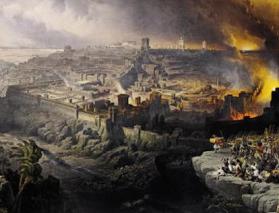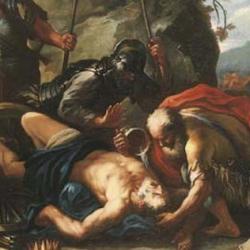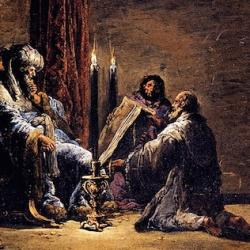Overall, the Chronicler’s account of Solomon’s temple construction (2 Chronicles 3:1-5:1) is arranged chiastically:
A. Solomon begins to build, 3:1-2
B. What Solomon made, 3:3-4:10
C. What Huram-abi made, 4:11-17
B’. What Solomon made, 4:18-22
A’. Solomon completes (shalam) work, 5:1
The long section in B is itself a chiasm:
A. Foundations and dimensions, 3:3-7
B. Most Holy Place, 3:8-14 (gold; house, cherubim, veil)
C. Doorway and court, 3:15-4:5 (bronze; pillars, altar, sea, 10 basins)
B’. Holy Place, 4:6-8 (gold; 10 lampstands, 10 tables, 100 bowls)
A’. Court of priest and great court, 4:9-10
After a description of the dimensions and materials of the house of Yahweh (2 Chronicles 3:1-7), the Chronicler enumerates the items that Solomon “made” (‘asah) for the temple. There are thirteen made-things, the list marked by the repetition of the phrase “and he made”:
1. House of inner sanctuary, 3:8
2. Cherubim, 3:10
3. Veil, 3:14
4. Pillars, 3:15
5. Chains for pillars, 3:16a
6. Pomegranates for pillars, 3:16b
7. Altar, 4:1
8. Sea, 4:2
9. 10 water basins, 4:6
10. 10 golden lampstands, 4:7
11. 10 golden tables, 4:8
12. 100 golden bowls, 4:8
13. Court for priest and the great court, 4:9
After a brief description of things that Huram-Abi made (4:11-17), the Chronicler returns to Solomon to describe three additional things he made: “all these utensils” (4:18), “all the things that were in the house of God” (4:19), and “all the work” (5:1). Gold items are reserved for Solomon, but the Israelite-Gentile Huram assists with bronze work.
Some form of ‘asah is used six times in the list of Huram’s makings (v. 11 says “Huram also made the pails . . . . So Huram finishing making the work which he made”). In sum: 13 makings of Solomon + 6 makings of Huram + 3 makings of Solomon = 22 makings, 22 being the number of letters in the Hebrew alphabet. The text presents an alphabet of construction, construction of aleph to taw.
If we exclude the final item, the list divides neatly into four groups of three items each. Each group is associated with one of the zones of the temple. The Chronicler begins in the Most Holy Place, with the room itself and the free-standing cherubim; that group ends with the veil (paroket) that separates the inner sanctuary from the palace (heykal, 3:13).
He skips the holy place for the moment, and describes the pillars that stand at the doorway of the temple. Three items are “made” – the pillars and capitals themselves, the chains that are strung on the capitals, and the pomegranates that are attached to the chains. Though we are not told in 2 Chronicles, we know from 1 Kings that the pillars are bronze.
From the doorway, he moves out to the court to describe three items—a new and larger bronze altar, a great sea on the backs of twelve oxen, and ten water basins for washing ascension offerings and priests. Finally, he moves back into the temple, describing the furnishings of the heykal—ten lampstands, ten tables, and one hundred bowls.
The movement is chiastic:
A. Inner sanctuary – dimensions, cherubim, veil
B. Outer doorway – pillars, chains, pomegranates
B’. Outer court – altar, sea, basins
A’. Heykal – lampstands, tables, bowls
Several things indicate that the items in each group are parallel and mutually-interpreting. Though we’re not explicitly told that the cherubim stand on the right and left of the ark, that is the clear implication of the complex description of their placement (3:11-12). In every other list, we learn that there are also things “right and left” – pillars (3:17), basins (4:6), lampstands and tables (4:7-8). 4:10 clarifies what orientation the Chronicler is using. The sea is to the “right,” and that is explained as “southeast.” Since the temple is oriented on an east-west axis, and the south is to the right, right and left are being described from the perspective of someone within the temple looking out. That is, right and left are designated from the perspective of Yahweh enthroned in the inner, western sanctuary, facing the eastern front door.
The linkage of these right-and-left descriptions suggests that the pillars, basins, lampstands and tables are joined up with the cherubim in the inner sanctuary. What the cherubim represent is elaborated by the items that are visible right and left; cherubim stand at Yahweh’s right and left as pillars, basins, lamps, tables, serving to cleanse, illumine, and feed.
Another odd detail reinforces that linkage of inside and outside. 3:16 states that Solomon made the chains “in the inner sanctuary” and then set them on the capitals of the pillars. If we take this at face value, the inner sanctuary serves as a foundry. It’s a strange idea, and many have taken the phrase as an interpolation or a scribal error. Perhaps we can make sense of it. Even if the chains were not literally forged in the inner sanctuary (which is undoubtedly the case), the chains are understood to come from the inner sanctuary and then placed like crowns on the pillars’ “heads” (Heb. ro’sh; and of course our “capital” is also etymologically a caput, capita, head). The pillars and capitals, visible to everyone in the court, manifest on the “face” of the house the secrets of the inner chambers.
If we throw Zechariah 4 into the mix, perhaps we have this picture: Two cherubim in the inner sanctuary are anointed ones who serve as the source the visible glory of Solomon’s kingdom. And, if we remember that the temple is an architectural man (pointing to the Temple that is Jesus), then the Chronicler’s temple account might offer some fuel for reflection on the relation of public “face” to the inner workings of the heart.















